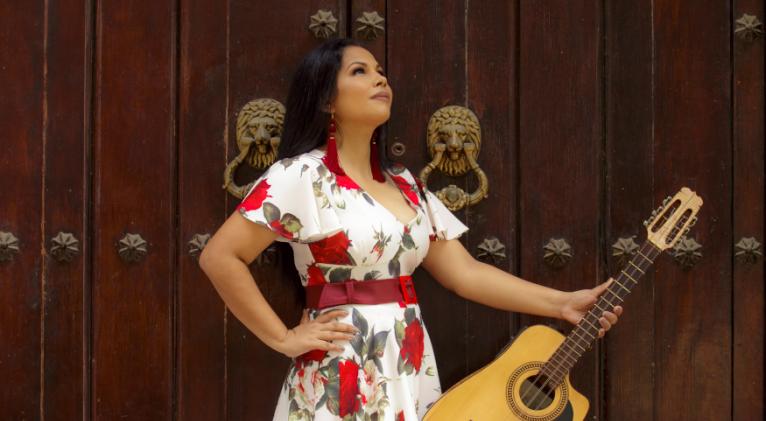Yarima Blanco and The Tres Guitar Were Born for Each Other

Anyone who has seen her play knows what I'm talking about when I say that Yarima and the tres guitar were born for each other: the connection is so strong, the way strings respond to the emotion, the energy, the feeling of the woman who strings them and finds their best sound, that an expert ear is not needed, a sensitive one is enough to admire her.
However, this tall and beautiful girl is just as simple and approachable. She has both talent and character and she talks almost as fluently as she plays the tres guitar.
In Studio 18 of EGREM, she spoke exclusively with CubaSí.
What paths led you to the tres guitar?
"My beginnings were at the Rafael Cabrera elementary school, in Bayamo, I studied classical guitar for five years and then I was given the chance to come to the National School of Art (ENA) to study tres guitar, thanks to a great friend, Niurka Trueba, who showed me the way and told me: you should apply for ENA for the tres guitar specialty and today I thank her very much.
"I began studying in 1996 with the help of maestro Efraín Amador, who was the creator of the tres guitar and lute Group. I studied for 4 years at ENA and then continued at the Instituto Superior de Arte, where I graduated in 2006 and I became the University's first tres guitar female graduate."
You were one of the first tres guitar girls then...
"In those years it was very rare to see women playing tres guitars, so, certainly, it was my salvation, because there were many female guitarists, but there were few in tres guitar.
"Along the way I realized that I was having a unique opportunity in my hands, in a way to make a little difference in terms of history of this string instrument that defines so much Cuba, the Cubans, that is part of our identity. For me it was wonderful to embrace this idea and it has been my path, my trajectory..."
What connected you with the instrument?
"Somehow, it became easy for me to recognize myself with this instrument that has a lot of potential, a lot of Cuban identity, of improvisation, I’d say that it has a certain character. So that suits me greatly, I am a woman of character, I like to express my feelings through the instrument and there I found that possibility of expressing in an artistic way.
"I fell in love with the instrument, the closeness it had with the guitar, the timbral sound, temperamental and at the same time sweet. Finding that duality: at times, the temperament to improvise in Cuban music, in the Cuban son music, in the changüí, but I also took it to classical music, because I played a lot of classical music, so there’s also the closeness with the lute, with the bandurria, I fell in love with that, because I began to discover a whole different field of possibilities the instrument had and I fell in love with it.
What projects are you busy with right now?
"Right now we are promoting some songs included in the album Pa' mi tres. On February 14 we released our last video clip called Muda mi alma, it was a video made in Guatapé, Colombia, a very beautiful town. We are promoting these audiovisuals and, personally, I’m working on a space that I have on my YouTube channel, called Miércoles de Tumbao. I plan to return to it soon, with interviews with people from the world of traditional Cuban music, of tres guitar, new sessions will be released soon.
"Besides, doing many collaborations, I’m always very active with calls from all over, fusing especially the tres guitar, not only focusing on the son and Cuban music, but taking it to jazz, pop, merengue.
"Thanks to those collaborations I’ve had the opportunity to open a different range in the tres guitar. That also helped me a lot the fact that I worked for a long time in Anacaona orchestra and with them I played jazz, timba, pop, a ballad and I saw myself in the need to give the tres guitar a different language so that it could adapt to all these genres.
And do you also keep working with your group?
"Yes, my group is called Yarima Blanco y son Latino, we are preparing a next album, looking for new sounds, very attentive to what’s happening with current music, trying to update ourselves in the percussions, the harmonies...
"Last year we had the fortune of touring Europe for 4 months, performing at the most important festivals and that has helped us to have a look at what paths the world is taking with traditional music, which is alive and is renewing in a very special way and we have to pay close attention.
From your vision as an instrumentalist, are there limits to the tres guitar?
"I’d say that there are no limits. Nowadays there are musicians who are taking the instrument to other languages, using, for example, the tres guitar with pedals just like an electric guitar, this gives you the opportunity for totally different sounds. The tres guitar, included within classical music, within pop, coincidentally I was recently seeing that, thanks to that young school, which is renewed with all the boys and girls who are studying the instruments is already reaching pop.
"I saw on social media that singer Camilo has a tres guitar within his group, because the pianist acquired one and is introducing it into pop, that is, I believe the instrument is gaining ground like never before."
Translated by Amilkal Labañino / CubaSí Translation Staff














Add new comment